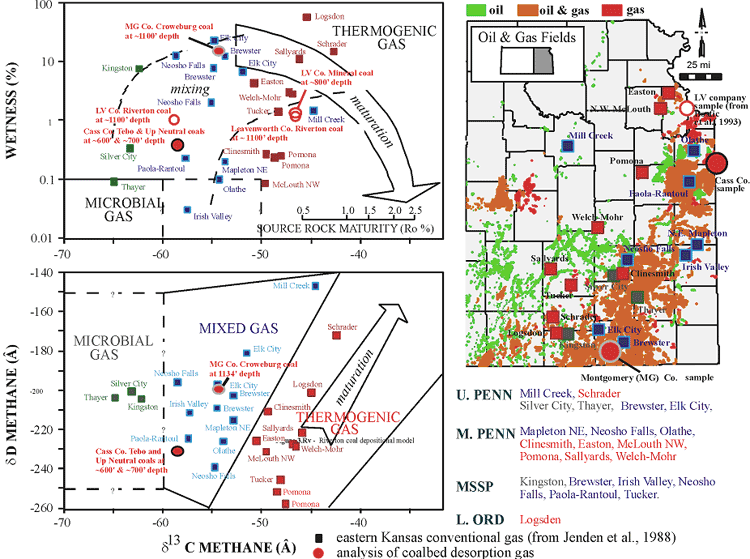 |
|
Kansas Geological Survey Open-file Report 2003-82 |
Chapter Three: Coalbed Gas in the Cherokee Basin
The first test in Kansas to assess coalbed gas potential in southeastern Kansas was from several wells drilled during the late 1980’s in Wilson and Montgomery counties (Stoeckinger, 1989). Desorption analyses were conducted on the Mulky, Weir-Pittsburg, and Riverton coal beds and gas contents were determined to be more than 200, 220, and 190 scf/ton, respectively (Stoeckinger, 1989). Additional testing of coalbed gas potential continues with many independent oil and gas companies operating in eastern Kansas. Detailed desorption data collected by the Kansas Geological Survey from several wells in eastern Kansas will be released during late 2003 and into mid 2004. Currently the KGS Cooper CW #1 (11-T35S-R18E, Labette County, Kansas) is the only well with desorption data available through an open-file report.
3.2 Geochemical Composition
Conventional gas from both oilfields (associated gas) and gasfields (nonassociated
gas) in eastern Kansas range in origin from thermogenic, to microbial carbon
dioxide reduction, and microbial origins, based on crossplots of the![]() ,
,![]() and
wetness of methane (Jenden et al., 1988; Figure 3.01). In cooperation with
operators, two gas samples were recovered from Cherokee Group coal samples
during desorption, and sent to an outside laboratory for isotopic analysis
(Isotech Laboratories, Champaign, IL). These samples have similar intermediate
and
wetness of methane (Jenden et al., 1988; Figure 3.01). In cooperation with
operators, two gas samples were recovered from Cherokee Group coal samples
during desorption, and sent to an outside laboratory for isotopic analysis
(Isotech Laboratories, Champaign, IL). These samples have similar intermediate
![]() vs.
vs. ![]() composition, suggesting mixed thermogenic and microbial origins (Figure 3.01).
The mixed origin of coal gases in eastern Kansas is also supported by the
plot of wetness versus methane
composition, suggesting mixed thermogenic and microbial origins (Figure 3.01).
The mixed origin of coal gases in eastern Kansas is also supported by the
plot of wetness versus methane ![]() ,
where the coal gas samples plot below the thermogenic arrow and in the region
of mixed microbial and thermogenic gases (Figure 3.01).
,
where the coal gas samples plot below the thermogenic arrow and in the region
of mixed microbial and thermogenic gases (Figure 3.01).
Pennsylvanian rocks are mature to marginally mature in the eastern part of Kansas where Cherokee Group coals have vitrinite reflectance values of 0.5 - 0.7% (Jenden et al., 1988). Considering degree of maturation and gas geochemistry, conventional and coal natural gases in eastern Kansas are a combination of indigenous dry microbial methane, and either indigenous or migrated early thermogenic methane. An additional source of indigenous thermogenic methane is the black shale that typically overlies each coal. Also, longer distance migration of thermogenic gases into Cherokee Group reservoirs in Kansas may have occured along the regional Mississippian-Pennsylvanian unconformity from the Arkoma basin in northeastern Oklahoma (Jenden et al., 1988).
 |
| Figure 3.01 - Plots of conventional gases sampled compared to coal bed gases sampled in eastern Kansas (modified from Jenden et al., 1988). |
e-mail : webadmin@kgs.ku.edu
Last updated December 2003
http://www.kgs.ku.edu/PRS/publication/2003/ofr2003-82/chapter3.html